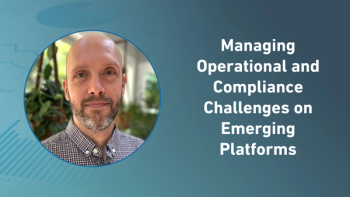
Treating Oncogenic Mutations in Clinical Trials
Richard Williams, PhD, chief medical officer at Kinnate Biopharma Inc. discusses clinical trial strategies and challenges.
Many patients with cancer, while treated successfully by first in-line therapies, often have tumors that build resistance as the cancer mutate. This challenge has spurred a new need for highly targeted therapies unique to patients’ mutation type, and start-up biopharma is getting in on the action. In this interview, Richard Williams, PhD, chief medical officer at Kinnate Biopharma Inc., will discuss clinical trial strategies and challenges.
Moe Alsumidaie: Can you give me a brief overview of Kinnate and how you approach R&D? What is unique about the R&D process that sets you apart from others in your space?
Richard Williams: The way we think about this starts from a patient-centric approach and recognizing that patients are not being adequately treated today with targeted cancer therapeutics. Unfortunately, only about 10% of patients with cancer today have an approved targeted therapy for their specific mutation. Nearly half of those patients’ tumors do not respond, and many of the responding patients ultimately will develop acquired resistance.
As a precision oncology company, we focus on expanding the promise of targeted cancer therapies by designing molecules that target validated oncogenic drivers for which there are no approved targeted therapies today or are designed to overcome resistance to approved and available targeted drugs. We have a productive discovery engine, one where we focus on the unmet need in validated oncogenic drivers. We bring deep in-house medicinal chemistry and biology expertise to focus on structure-based drug design approaches. And to this, we incorporate a network of tailored external partnerships, including medicinal chemists at CROs, which enable us to rapidly scale and fine-tune this engine based on the study need. We have two clinical-stage programs, one targeting cancers driven by BRAF Class II and Class III alterations, a second program targeting cancers caused by FGFR2 and FGFR3 alterations, and multiple programs in the research stage to have up to one IND per year. All our programs and development candidate drugs are fully developed in-house.
MA: What types of cancers are you targeting? Some focus on all types of tumors, whereas others focus on a particular kind of tumor when they’re going into development. What is your strategy, and why?
RW: In our programs, the oncogenic driver alteration and associated biology are both the target for our drug and represent our key patient selection strategy—thereby maximizing opportunities to demonstrate clinical benefit. We work broadly across multiple adult solid cancers, partly because the oncogenic drivers we are interested in are represented across many cancer types. So, for example, in our RAF program, while lung cancer and melanoma are the two areas with the highest rate of BRAF alterations, there are many other cancer types where BRAF alterations are present. Therefore, there is an opportunity to develop more effective therapies for various cancer types.
MA: Can you tell me the differences between Class I, II, and III inhibitors?
RW: Great question. Class I BRAF inhibitors are designed only to inhibit BRAF monomers, and these drugs do not have clinical benefits in patients with non-V600E or non-Class I BRAF alterations. This is due to their inability to bind and inhibit both components of the BRAF dimer, a characteristic feature of this non-Class I BRAF alteration. In the case of BRAF Class II alterations, mutant BRAF functions as BRAF/BRAF homodimers, while in BRAF Class III alterations, BRAF and CRAF function as heterodimers.
When we think about an optimal profile for a pan-RAF inhibitor, it has to be designed to target a broad array of BRAF alterations with high kinome selectivity and activity across a range of BRAF alterations at a tolerated dose. In addition, you need differentiated pharmaceutical properties that allow the inhibitor to maximize target exposure and pathway inhibition while minimizing a feature called paradoxical activation, which is a liability observed with the approved Class I BRAF inhibitors. So given all of those requirements to develop an optimized profile, it’s been very challenging today for the field to generate effective drugs that possess that kind of optimized profile.
We believe we’ve developed a drug with KIN-2787 that fulfills those criteria. Ultimately, the test will come in our clinical program regarding how effectively our highly selective pan-RAF inhibitor KIN-2787 will demonstrate activity across BRAF and CRAF monomer- and dimer-driven cancers while achieving sustained exposures and minimizing paradoxical activation.
We estimate that a pan-RAF inhibitor like KIN-2787 ultimately also has the potential to address more than half of the patient population who develop resistance to BRAF Class I targeted therapies. So, as a result, our clinical strategy for KIN-2787 is to enroll those patients who are most likely to benefit from our drug, including patients with BRAF Class II and Class III alteration-driven cancers, patients with BRAF Class I driven cancers with acquired resistance to approved RAF inhibitors, and patients with NRAS mutated melanoma, cancer driven through CRAF.
We recently announced an update from our monotherapy dose escalation for KIN-2787, in which the drug cleared the predicted efficacious dose at 300 mg bid. The dose escalation continues at 400 mg bid with the maximum tolerated dose not yet determined. In addition, KIN-2787 achieved meaningful exposures that were dose proportional and exceeded the predicted efficacious thresholds based on preclinical models.We’re encouraged by the initial clinical responses with KIN-2787 monotherapy thus far and look forward to sharing a detailed dose escalation data in the first half of 2023.
MA: Can you tell me about your observation regarding the FDA and if you believe it’s raising the bar on clinical trial development and accelerated approval pathways for targeted therapies in oncology? What does this mean for your studies?
RW: I would start by saying that for all clinical programs, the FDA expects sponsors to establish a favorable benefit-risk profile for their drug, so that continues to be the case and has not changed. The bar remains arguably relatively high in targeted oncology because you are addressing a patient population with a significant unmet need, given the poor outcomes for many cancers we’re studying. The accelerated approval pathway provides an opportunity to develop, and ultimately, the goal is to achieve approval for your drug in treatment for patients with severe and life-threatening conditions. But this is based on the utility of a surrogate endpoint, a marker that’s thought to predict clinical benefit. For example, measurements of tumor shrinkage—an area where the bar is being scrutinized. This will continue to attract a significant amount of attention and expectation for sponsors to have planned and initiated, and even better made substantial progress toward completing enrollment in a confirmatory Phase III trial. These are typically the trials required to demonstrate definitive improvements in clinical benefit for patients, usually using either progression-free survival or an overall survival benefit for the drug under study.
Indeed, from our point of view, targeted therapies have and will continue to transform patient care for many cancer types through the accelerated approval pathway for patients like those who participate in our two clinical programs. This is the pathway we plan to seek approval for our drugs if and when supported by the clinical data representing a favorable benefit-risk assessment. We’re excited to share detailed monotherapy dose escalation data from our lead pan-RAF program, KIN-2787, in the first half of 2023.
MA: Thinking about the impact of COVID on clinical operations, can you tell me a bit about what sorts of challenges and things are keeping you up at night?
RW: It’s been a mix of both—some opportunities and some challenges that have come about in the last couple of years because of the COVID pandemic. From a positive point of view, I would highlight that in terms of the execution of clinical studies, including Phase I studies, we and our clinical trial partners and investigators, and the scientists we work with have been able and willing to introduce more flexibility on patient management - for example, remote visits and patient monitoring, remote lab assessments, with some ability to decentralize activity, while maintaining appropriate oversight and not compromising patient care. So that’s additional flexibility that I think many sponsors in the industry have welcomed and observed due to the pandemic. But there have been some challenges. One that we would highlight is resource constraints at clinical sites that sometimes cause difficulties with staffing and resourcing at clinical trial sites.
In some cases, this may impact how quickly and efficiently a sponsor can activate a clinical trial site from selection to the point at which that clinical center is ready to start screening and enrolling patients. We are proud of the progress we are making with the number of active clinical trial sites for our RAF and FGFR programs. I would highlight that in our RAF program, that study is active in more than 20 clinical sites across the globe.
MA: What are you doing to optimize the protocol to maximize the enrollment potential for your trials?
RW: We take a few approaches. Number one, while identifying patients with specific genetic alterations is crucial and a central part of our strategy, we provide flexibility. Patients can come forward and participate in our trial if they have the specific genomic alteration either identified in tumor tissue genomic analysis or from blood-based analysis, so-called circulating tumor DNA analysis, as well. Either approach, tissue or blood, provides flexibility to allow patients to come on to study if they have the appropriate genomic alteration. We also allow prior tumor genomic analysis conducted previously to enable patients to participate in our study, meaning that new, time-consuming genomic testing is not required to support study enrollment. Lastly, a point we touched on earlier, we allow patients across a wide array of cancer types to participate in the study. For example, in the KIN-2787 study, while we believe that lung cancer and melanoma are two areas of high unmet need, many cancer types are appropriate and relevant for our clinical program.
MA: If you had one message or advice to people designing clinical trials with targeted oncology, what would that advice be?
RW: In a word, it would be the focus. Our approach targets validated oncogenic drivers with a clear understanding of the pathway that drives cancer. We are developing our compounds for use as single agents and in combination with other targeted therapies based on prespecified markers for patient selection. We are focused on our strategy whereby the drug’s target is also the biomarker for patient selection, which maximizes the potential to demonstrate a clinical benefit for our patients. Additionally, our model is built upon continually leveraging translational research capabilities—this constant focus to understand new patient populations and responsive and resistant subsets of patients we may be able to help.
Newsletter
Stay current in clinical research with Applied Clinical Trials, providing expert insights, regulatory updates, and practical strategies for successful clinical trial design and execution.






.png)



.png)



.png)
.png)
